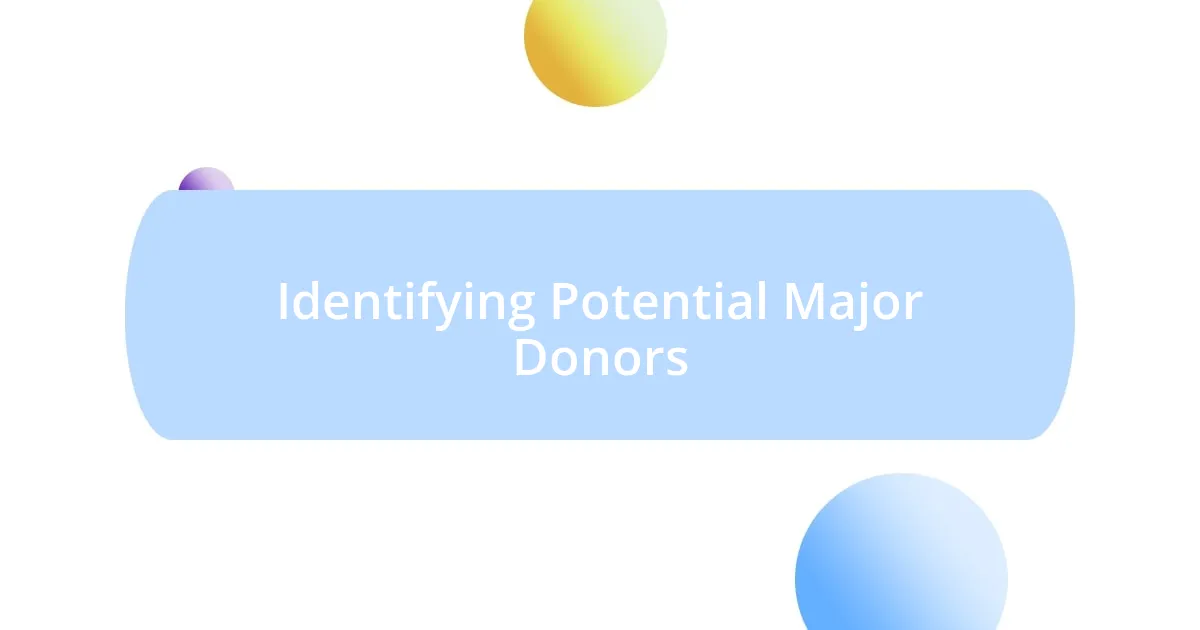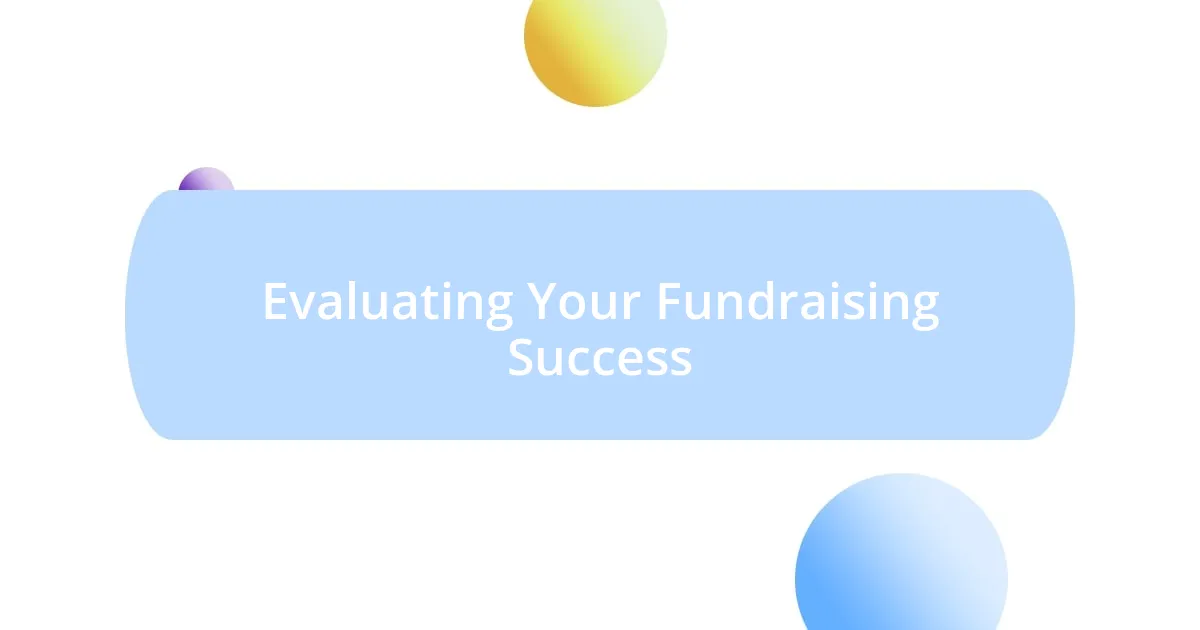Key takeaways:
- Major gifts fundraising hinges on understanding donor motivations and building genuine relationships, rather than solely focusing on financial asks.
- Identifying potential major donors involves thorough research into their personal interests, giving history, and community involvement.
- Effective stewardship requires ongoing engagement and personalized acknowledgments to nurture lasting bonds with donors.
- Evaluating fundraising success goes beyond the total funds raised; it’s essential to assess donor relationships and engagement for long-term impact.

Understanding Major Gifts Fundraising
Major gifts fundraising is a vital component of nonprofit success, focusing on securing large donations from individuals who are passionate about a cause. I remember when I first delved into this world—it felt like stepping into a vibrant community dedicated to making a real impact. What truly amazed me was how each major gift could transform not just projects, but lives. Isn’t it incredible to think that just one conversation could lead to a significant financial commitment that changes everything?
Understanding the motivations behind major gifts is crucial. I once spoke with a donor who shared that her contribution was inspired by her childhood experiences at a local shelter. It struck me how deeply personal stories can fuel generosity. Have you ever considered what drives people to give at such a high level? Often, it’s a profound connection to the mission and the desire to leave a legacy.
It’s essential to engage with potential major donors authentically. I’ve found that creating relationships built on trust pays off tremendously. Instead of just making an ask, I focus on sharing our vision and inviting them into our journey. This personal approach often leads to more than just funding; it’s about fostering lifelong partners who genuinely care about the impact we create together. How do you think these connections influence a donor’s decision to contribute significantly?

Identifying Potential Major Donors
Identifying potential major donors requires a keen understanding of their interests, passions, and connections to your cause. I remember sifting through community profiles and noting a donor who had previously supported arts education initiatives. When I learned about their background as a former art teacher, everything clicked. It was clear they saw our organization as an opportunity to continue advocating for a cause close to their heart. This experience taught me that research is not just about knowing someone’s financial capacity; it’s about diving deep into their personal journey.
Here are some strategies I employ to uncover potential major donors:
- Network Connections: Attend events where you can meet individuals related to your cause or existing donors who might introduce you to others.
- Analyze Giving History: Look into local philanthropy trends and major gifts your organization has previously received. Patterns can signal potential interest.
- Utilize Social Media: Platforms like LinkedIn can provide insights into a person’s professional background and philanthropic engagements.
- Engage with Current Donors: Ask your existing supporters if they know anyone who shares a passion for your mission. They often have valuable insights.
- Research Community Involvement: Identify those involved in local nonprofits, boards, or community initiatives. It often points to a readiness to engage with your organization.
With the right approach, discovering those who are likely to resonate with your mission becomes an exciting journey, one that often leads to meaningful partnerships.

Building Relationships with Donors
Building genuine relationships with donors is at the heart of effective major gifts fundraising. I recall a time when I had a coffee meeting with a potential donor. Instead of diving into a funding request straight away, I took the time to listen to her thoughts on the local community. We shared stories about our experiences, and by the end, we had forged a connection that felt meaningful. It was in that moment I realized: relationships matter more than the pitch itself.
The key to engaging donors is recognizing that they are not just sources of funding—they are individuals with values and aspirations. I once went to a fundraising event with a donor who had supported us for years. During the event, she spoke passionately about how her investment had created real change in our community. Witnessing her pride in contributing to our mission reminded me that it’s these emotional connections that inspire deeper commitment. How many times have you felt moved after hearing a personal story tied to a cause?
Moreover, maintaining those relationships requires consistent effort. I make it a point to update donors on project developments, and I send personalized thank-you notes that reflect our conversations. One particular donor told me he appreciated being remembered on his birthday, which led me to reach out with a simple message each year. These small gestures can transform a transaction into a partnership. As you think about your own donor relationships, consider what unique touches you could implement to deepen those connections.
| Relationship Building Aspect | Strategy |
|---|---|
| Personal Connection | Engage with stories and shared interests. |
| Emotional Engagement | Highlight the impact of their contributions. |
| Ongoing Communication | Regular updates and personalized thank-you gestures. |

Navigating the Ask Conversation
Navigating the ask conversation can feel daunting, but I’ve found that preparation is key. A few months ago, I approached a potential donor I’d cultivated a friendship with over lunch. Instead of launching into my funding needs, I shared a heartfelt story about a child whose life changed thanks to our programs. Looking in her eyes, I knew this emotional connection was the path forward, and it led to a truly impactful conversation about how she could help.
One effective strategy is to ask open-ended questions that encourage dialogue. I remember asking a past donor, “What excites you about philanthropy?” This question opened the door to discussing not just her interests but also areas of our mission that aligned closely with her passions. It made me realize that every donor has a personal connection to their giving, and tapping into that makes the ask not just about funds, but about shared goals and aspirations. Have you ever thought about how your requests could align with a donor’s personal mission?
Listening is equally vital during the ask. In a particularly memorable meeting, after making my request, I paused and simply listened. The donor shared her thoughts on how important sustainable solutions were to her. This conversation helped me tweak my proposal to reflect her values, turning what might have been a standard ask into a tailor-made partnership approach. It solidified for me that when we truly listen, we can navigate the ask with authenticity, ensuring it resonates on a deeper level.

Thanking and Stewarding Major Donors
When it comes to thanking major donors, I’ve learned that a simple “thank you” is just the beginning. One time, after receiving a significant contribution, I decided to host a small gathering to celebrate our donors’ impact. I shared updates about the projects they were supporting, and seeing their reactions was priceless. Their smiles and pride radiated throughout the room, reinforcing for me how vital personalized acknowledgments are.
Stewarding major donors goes beyond immediate thank-yous; it’s about nurturing a lasting bond. I remember a donor who had been with us for several years, and yet, I realized I hadn’t reached out personally in months. So, I organized a phone call to catch up. She shared stories about her family and how our mission aligned with her values. That simple gesture reestablished our connection and reminded me that meaningful stewardship takes effort and genuine interest. How often do you make time to really engage with your donors?
In my experience, it’s those extra touches that truly resonate. I once took the time to create a custom impact report for a donor, highlighting not just the numbers but the personal stories behind their gift. I included a handwritten note that mentioned how their specific contributions had changed lives in our community. The gratitude I received in return was overwhelming. It’s moments like this that reinforce my belief: a little thoughtfulness can leave a lasting impression and transform financial support into heartfelt advocacy. What creative thank-you gestures can you think of that might truly resonate with your donors?

Evaluating Your Fundraising Success
Evaluating your fundraising success is an enlightening journey that involves more than just tallying funds raised. I remember after a major campaign, I sat down with my team to reflect on not only the dollars collected but the relationships built along the way. It struck me that understanding the motivations of our donors and the impact of their giving was equally — if not more — important than the financial totals.
Another aspect I focus on is the feedback loop. I often reach out to donors post-campaign to gather their insights and feelings about our collaboration. There was one instance where a donor expressed that she didn’t just want to write a check; she wished to be involved in shaping our programs. This conversation wasn’t merely about evaluating success; it revealed a whole new dimension of engagement we hadn’t tapped into yet.
Lastly, analyzing metrics such as donor retention and engagement levels can be eye-opening. During one evaluation, I realized that while our major gift income increased, we were losing some smaller supporters. This highlighted a critical area for improvement. It made me question: are we doing enough to ensure every donor, regardless of their gift size, feels valued and part of our family? This understanding reaffirmed my belief that success isn’t just in the numbers — it’s in the relationships we cultivate and the communities we build.














